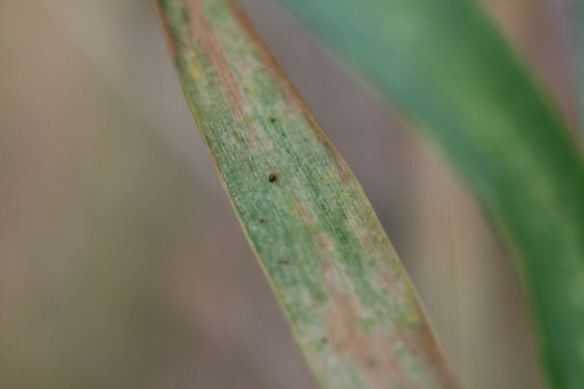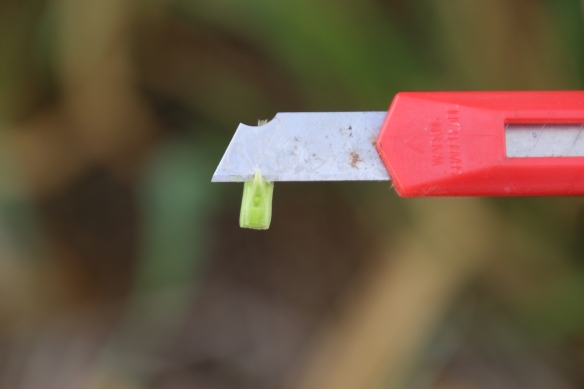Wheat disease updates are written by Dr. Bob Hunger, OSU Extension Plant Pathologist
Oklahoma: Again, a cool and moist week in Oklahoma with rain and cool temperatures in the forecast through the weekend. Wheat is mostly at flowering around Stillwater but by early next week will likely be past flowering. From what I hear across the state, wheat is quickly approaching, at, or will be quickly past flowering (depending on what part of the state, when planted, and how much drought stress was endured).
Around Stillwater there has been an increase in stripe rust and powdery mildew (especially stripe rust). Leaf rust also has increased, but not to the same extent (incidence or severity) as stripe rust. Dr. Brett Carver (OSU Wheat Breeder) indicated he saw significant stripe rust in his nurseries at Lahoma (north-central OK). Gary Strickland (Jackson County Extn Educator) also has observed an increase in stripe rust (and to a lesser extent, leaf rust) in far southwestern Oklahoma. My impression is that stripe rust has activated again with the cool and wet weather, and continues to spread across Oklahoma. This Thursday and Friday there will be field days in central Oklahoma, so look for a more extensive report next week.
To the south of us in Texas (far southern Texas), Dr. Amir Ibrahim (Professor, Small Grains Breeder/Geneticist; Texas A&M AgriLife Research; College Station, TX) has indicated in breeder nurseries near Castroville, TX, that there is a mixture of stripe rust, leaf rust, bacterial leaf streak and some septoria. This has occurred because of back-and-forth switching between cool and warm temperatures mixed in with lots of rain. To some extent, this also has occurred across Oklahoma during April.
Mite-transmitted viruses also are prevalent in Oklahoma this year. Yesterday when in nurseries here at Stillwater I noticed occasional trapped heads scattered throughout the field. In observing these in the lab using a dissecting scope, I found wheat curl mites associated with these trapped heads. Although only sporadic around Stillwater, the Diagnostic Lab has received multiple samples that they confirmed for presence of Wheat streak mosaic virus, Wheat mosaic virus (High plains virus), and/or Barley yellow dwarf virus. This includes samples from Grady, Noble, Grant, Texas and Woods Counties. I would refer you to EPP-7328 (Wheat Streak Mosaic, High Plains Disease, and Triticum Mosaic: Three Virus Diseases of Wheat in Oklahoma) available at http://osufacts.okstate.edu for more information on these mite-transmitted viruses.
Reports/excerpts of reports from other states:
Kansas: Doug Shoup (SE Area Crops/Soil Specialist) & Erick DeWolf (Extn Plant Pathologist), Kansas State University, 22-Apr-2015: “Stripe rust has been found in several fields of wheat in southeast , south central, and north central Kansas. Given the forecast of cool and relatively wet conditions for the next seven days, this is a potentially significant situation for fields anywhere in Kansas planted to varieties susceptible to stripe rust. Intensive scouting of fields should begin now.” [This was the first paragraph of their report, which can be found at:
https://webapp.agron.ksu.edu/agr_social/eu_article.throck?article_id=532


















